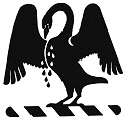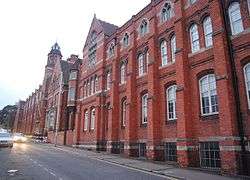Chatham House Grammar School
Chatham House Grammar School was an all boys grammar school in Ramsgate, Kent, England, that was merged in September 2011 with its sister school Clarendon House Grammar School to become the Chatham & Clarendon Grammar School.
| (Former) Chatham House Grammar School | |
|---|---|
 Pelican in Her Piety | |
| Address | |
Chatham Street , , CT11 7PS | |
| Information | |
| Type | Grammar school Academy |
| Motto | Latin: Floreat Domus Chathamensis (May Chatham House Flourish) |
| Established | 1797 |
| Founder | Dr William Humble |
| Local authority | Kent |
| Specialist | Science Mathematics & Computing |
| Department for Education URN | 136382 Tables |
| Ofsted | Reports |
| Gender | Boys; Coeducational (sixth form) |
| Age | 11 to 18 |
| Former pupils | Old Ruymians |
| New name | Chatham & Clarendon Grammar School |
| Merged | 2011 |
| Website | http://www.ccgrammarschool.co.uk/ |
It had a coeducational sixth form and shared teaching facilities and various A Level courses with Clarendon House Grammar School. The two schools worked together to provide subjects, bands, and outings. Both schools were co-ed from the sixth form (Year 12 and 13).
History
Chatham House was founded in 1797 by Dr. William Humble along Chatham Street, although there is evidence that the school had existed prior to its formal establishment. The school underwent major changes during the 1800s. The buildings were renovated and expanded, rugby and hockey were also introduced into the sporting programme.[1]
World War II
When Ramsgate was bombed during World War II, a bomb hit the school library (where a skylight now stands) but did not detonate. Prior to that, the library had been the school chapel, as evidenced by the amount of stained glass windows situated quite high up.
The school had numerous entrances to private shelters used in the second world war to shelter from air raids. Most of these entrances were covered up (now underneath the playing fields) but the last ones are still visible on the lower playground and have been used recently by the local fire authorities for training purposes.
In a carpark of the school there is also a slabbed-over entrance to the Ramsgate A.R.P. tunnels, which ran for around 3.5 miles. These are not connected to the school shelters.

The main building of the school as well as the railings were grade II listed.[2]
Admissions
The school had approximately 813 students including the 262 students in the sixth form, accepting only boys in years 7-11, and a limited number of girls in the sixth form, mostly drawn from the Isle of Thanet that encompasses Ramsgate, Broadstairs and Margate, but some from as far away as Herne Bay and the Whitstable area. Chatham House is situated just south of the junction of the A255 and the A254.
On 4 March 2008, the school had an Ofsted inspection which rated the school as outstanding - the highest grade achievable.[3] All areas that were inspected were found to be Grade 1 (outstanding) or Grade 2 (good) and the school was praised for its work.
The school had the highest rate of GCSE and A level passes in Kent, 73% of students taking their GCSEs last year got A* to C.
Uniform
The school maintained a strict system of uniform throughout all years, including the sixth form. The uniform consisted of a dark green blazer, dark trousers, white shirt and a green tie striped with the correct form the pupil was placed into.
In the senior school (years 9-13), ties were also green and striped as previously mentioned.
Some pupils also became eligible to wear ties in recognition of other achievement. House 'colours' were similar to the house tie but with a white stripe running along each side of the coloured stripe.
School 'colours' were a single white school crest on a dark green tie with a white stripe. There were also 'colours' for sport and music, which consist of a repeating pattern of white stripes and the school crest and were earned by representing the school's first team in 75% of the matches in a season.
House system
The school had a house system with the junior school consisting of years 7 and 8. From year 9, the pupils joined the senior houses. In total there were 8 houses, 4 junior school houses and 4 senior school houses. In the senior houses pupils wore a tie indicative of their house. In year 12 (or lower sixth) the form groups were split into two. The nomenclature for representing a pupil's house was: 7M, 11P, 12T(ii)
The current house system involves the same four houses for all years - 7 to 13, and are represented in the form of Year Number, House Initials, Gender. For example: 7TSB, 9KHG, 10MSG, 10RPB. There are many different competitions throughout the school year in which the houses are crucial, i.e. the Swimming Gala, and the Music Cup. Depending on how well the houses do, they gain points in different integers.
All ties for both senior and junior site consist of a green tie striped with the appropriate colours named below:
Current houses
- Rothschild-Pearce - Silver Stripes
- Thomas-Sharman - Red Stripes
- Mann-Somerville - Yellow Stripes
- Knight-Heath - Blue Stripes
Previous houses
- Heath's = white striped tie
- Mann's = orange striped tie
- Pearce's = green striped tie
- Thomas' = pink striped tie
Previous senior houses
- Coleman's - sky blue stripes
- Searle's - red stripes
- Norman's - purple stripes
- Thornton's = yellow striped tie
The house system was used for sporting events - house fixtures results accumulate over the academic year - and for various other competitions, including acting and design contests. The results from all of these fixtures were tallied at the end of each year to determine the winner of the Cock House Trophy.
Competition cups
Throughout the school year, the houses took part in competition cups, which contribute points toward the Cock House Cup. These included the Taylor Acting Cup, Larkin Music Cup, Chapman Design Cup and the Curzon Picture debating competition. Also, sports day events and general achievement contribute towards house points totals.
Awards system
In both Schools, as a form of award, teachers may give out rewards known as Achievement Points or Commendations. Depending on the amount which a pupil has, there are various certificates which are given, and also a prize in the form of a pin badge, which students can wear on their uniform. Below are the awards which pupils may receive, and the higher the commendations needed, usually the harder it is to obtain the specific certificate.
| Award | Achievement Points |
|---|---|
| Red Certificate | 10 |
| Blue Certificate | 20 |
| Green Certificate | 30 |
| Bronze Certificate | 40 |
| Silver Certificate | 60 |
| Gold Certificate | 80 |
| Platinum Certificate | 100 |
| Chatham and Clarendon Pin Badge | 50 + 100 |
Note that some houses repeat the commendation certificates for a second, third or possibly fourth round if pupils exceed 100 commendations - which warrants a Red Certificate No. 2. However, not all houses do this and some just keep to the standard seven certificates.
Merger
In 2009, Chatham House and the nearby girls-only Clarendon House formed the Chatham & Clarendon Grammar School Federation. The Federation became a new Converter Academy in January 2011, bringing greater control over admissions, site and buildings, curriculum development and much-needed additional income.
In Spring 2011, it was announced that the schools will work together as one school. Year 7, 8 and 9 pupils would be based at Chatham House and year 10 and 11 pupils would be based at the former Clarendon House.
Beginning September 2011, the new school Chatham & Clarendon Grammar School introduced a combined house system resulting from the amalgamation of old Chatham and Clarendon houses.
Notable alumni
Alumni of Chatham House are known as Old Ruymians.[4] Chatham House has the sixth highest number of Who's Who entries for state schools.[5]
Well known Old Ruymians include:
- Iain Aitch, author and journalist
- Herbert William Allingham, Surgeon to the Household of King Edward VII, and Surgeon in Ordinary to the Prince of Wales (later King George V)[6]
- Allan Butler, Ambassador to Mongolia from 1984–87
- Rear-Adm Timothy Chittenden, submariner and Director from 2000–03 of the Warship Support Agency
- Matt Corker, professional rugby union player for the London Wasps now Captain of London Welsh
- Maj-Gen Patrick Crawford GM, Commandant from 1989–93 of the Royal Army Medical College
- Jamie Davies, racing driver
- Matt Dunn, author
- Marc Gascoigne, fantasy writer
- Geoffrey Colin Guy CMG CVO OBE, Governor of Saint Helena (1976–81), and Commissioner of the Turks and Caicos Islands (1958–59, 1959–65)
- Sir Edward Heath, Prime Minister of the United Kingdom from 1970 to 1974[7]
- Stewart Jackson, Conservative MP for Peterborough (2005–2017)
- Sean Kerly, Olympic field hockey player
- Keith Parker, Former Deputy-Head, Town Close House School Norwich
- Lieutenant Marc Lawrence,[8] Sea King observer of 849 Naval Air Squadron, killed on 21 March 2003 in a crash in Kuwait
- Ali Marchant, radio personality & DJ
- John Marek, Labour MP for Wrexham (1983–2001)
- Desmond Misselbrook CBE,[9] Chairman from 1972–78 of Livingston Development Corporation
- Frank Muir, humourist[10]
- Rev Dr Edward Norman, gave the BBC Reith Lecture in 1978
- John Ovenden, Labour MP for Gravesend (1974–79); Leader of Kent County Council (1994–97)
- Geoff Parsons, Olympic high jumper
- Charles Robson (1859–1943), Middlesex and Hampshire wicket-keeper, and secretary (manager) of Southampton Football Club[11]
- Prof Robert Tavernor, Emeritus Professor of Architecture and Urban Design at the London School of Economics (LSE)
- Air Chief Marshal Sir Peter Terry, Station Commander from 1968 to 1970 of RAF El Adem in Libya; Governor of Gibraltar (1985–89).
- Nik Turner, founder of the space rock band Hawkwind
- Most Rev Gregory James Venables, Archbishop Primate of South America and Bishop of Argentina (2002–present)
- Air Chief Marshal Sir Bill Wratten CBE CB - Air Officer Commanding-in-Chief of RAF Strike Command during the first Gulf War, Station Commander from 1980–82 of RAF Coningsby
References
- "Chatham House - Chatham & Clarendon Grammar School - CCGS". Ccgrammarschool.co.uk. Retrieved 28 April 2017.
- "Results". Heritagegateway.org.uk. Retrieved 28 April 2017.
- "Grammar School Old Boys: Introduction". Chathamhouse.kent.sch.uk. Retrieved 1 April 2016.
- Staff (19 July 2005). "Coast: Point 4 - Pews and pupils". BBC. Retrieved 1 April 2016.
- "Allingham, Herbert William (1862 - 1904)". Plarr's Lives of the Fellows Online. Retrieved 5 July 2015.
- Heath, Edward. The Course of My Life. London: Hodder & Stoughton, 1998, p. 111
- "849 NAVAL AIR SQUADRON - Marc Lawrence profile". Naval849.co.uk. 23 June 2003. Retrieved 1 April 2016.
- "Desmond Misselbrook obituary". London, UK: The Independent. 23 March 2005. Retrieved 1 April 2016.
- Muir, F. (2000) A Kentish Lad. Transworld Publishers; ASIN:B000JFDP0S
- "Chales Robson profile". Cricketarchive.com. Retrieved 1 April 2016.
External links
- Chatham Clarendon Grammar School Federation Home Page
- Chatham House (previous website)
- OFSTED report
- EduBase